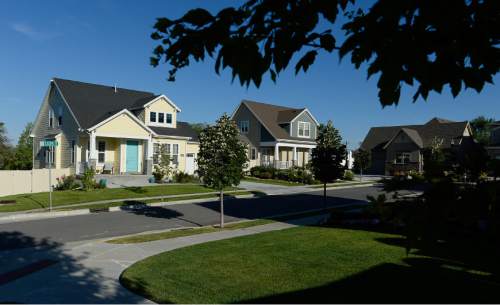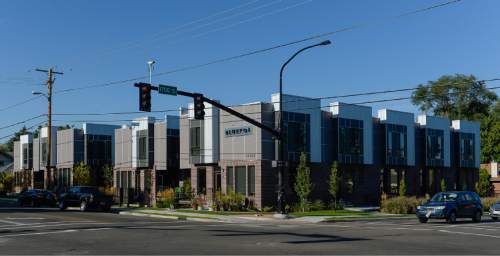This is an archived article that was published on sltrib.com in 2015, and information in the article may be outdated. It is provided only for personal research purposes and may not be reprinted.
When it comes to housing, urban development and transportation, there are signs that Utah's future is already taking shape, with heavy public support.
Planners and government leaders are readying for a doubling of the state's population within 35 years to 5.4 million residents, with most of those people living on the relatively thin strip of land known as the Wasatch Front.
The growth, officials say, will underscore key regional issues on available land, affordable homes, housing density and how many vehicle miles Utahns drive each day.
"The hard reality," said Ari Bruening, CEO of the nonprofit planning group Envision Utah, "is that this will force some trade-offs."
Yet tomorrow, in many ways, is here now.
Today, Utah's population centers are in the midst of an unprecedented building boom for apartments, while average lot sizes for single-family homes continue to shrink. New, more dense and walkable suburban commercial centers and transit-oriented developments are popping up across the valley. And the stage is set for added municipal funding of a variety of public transportation projects.
A pair of newly released polls suggests a majority of Utahns favors these ways of handling growth.
More than three of every four residents support having a mix of housing options in their communities, and they want neighborhood designs that encourage walking, public-transit use and shorter daily drive times, according to one Envision Utah poll.
Both elements, survey respondents said, are essential to keeping future housing and transportation costs reasonably affordable in coming years — especially for residents at lower incomes.
To that end, 81 percent of those polled said they were willing to allow more higher- density housing such as apartment complexes, duplexes, townhomes, mother-in-law and basement dwellings, as well as single-family homes on smaller lots.
—
Supporting density • The poll results come from a massive online survey effort dubbed "Your Utah, Your Future" that reached 52,845 state residents. Its findings on a range of major topics, such as housing, water, public education and air quality, are intended as a benchmark of public sentiment as policymakers ready for growth expected through 2050.
Recent housing-market data shows that at least part of that housing picture is already unfolding, at an unprecedented pace.
Salt Lake County has added 22,936 rental apartments since 2000, an average of 1,529 per year, according to a market study recently released by Cushman & Wakefield Commerce, a Salt Lake City commercial real estate brokerage. About 5,100 new apartment units are currently under construction countywide, the analysis found, and demand for such dwellings is unlikely to abate soon.
Apartment vacancy rates in the county stood at 2.7 percent in July, a 14-year low, and even if all the multifamily dwellings now on the drawing board are indeed built, vacancies "won't likely exceed 5 percent over the next year," the study said. "The market has had no trouble absorbing new units."
Analysts have attributed part of the apartment demand to young adults known as millennials, many of whom are choosing to delay marriage and home buying in favor of renting. But Bruening said the Envision Utah poll found that public support of mixed housing options spanned all demographic groups.
"When we cut the data by different generations, whether Baby Boomers or millennials, people feel the same way," he said.
Poll respondents also leaned heavily against urban sprawl fueled by large homes built on large lots, saying the approach was likely to drive up home costs and environmental impacts, increase their reliance on car travel, and lead to income-segregated neighborhoods.
City officials, home builders and urban planners all say that while Utah attitudes on housing density have been shifting for years, negative perceptions of multifamily projects — that they increase neighborhood crime and traffic and drive down property values — still persist. Many urban and suburban communities in Utah, they say, continue to constrain or resist outright most apartment construction and the idea of mixing types of housing together.
"Their plans call for the opposite, where they simply don't want that kind of growth or they're very limited in where they want to put it," said Chris Gamvroulas, president of Ivory Development, an arm of one of Utah's largest home-building companies.
Yet land-use patterns are gradually changing, data indicates, in light of market forces. As available acreage along the Wasatch Front continues to shrink, the average Utah home lot size is now less than half as large as it was a generation ago, according to Envision Utah research.
—
Mixing uses, driving less • The "Your Utah, Your Future" poll also found that most Utahns do not like the notion of converting farmland for housing projects, with 72 percent opposed.
The nonprofit group's housing poll also found broad public support in the state for mixed-use development and commercial clusters spread throughout urban and suburban neighborhoods instead of concentrated solely in downtown areas.
Nearly 80 percent favored development patterns that combine job centers, compact housing, retail outlets and places to recreate into single locations. Residents held that sentiment, the poll found, "even if it means a little inconvenience for cars, multi-story buildings close to people and somewhat greater traffic congestion combined with shorter drives."
As Utah's commercial real estate markets continue to rebound from the Great Recession, mixed-use centers are trendy, with dozens of such projects combining retail, office and residential uses being built and proposed. Often designed in conjunction with light-rail corridors, there are examples of clustering and transit-oriented development in communities across nearly all of Utah's most urbanized counties.
Mixed-use and development with a focus on multiple modes of transportation, Provo Mayor John Curtis said, "is on a roll."
Walking more and using cars less is a big theme. Eighty-two percent of those surveyed by Envision Utah said they supported mixed-use centers throughout the state's urban areas "where it is convenient to walk, bike, take public transportation or drive a short distance."
Reducing daily travel costs and reliance on cars were primary factors. But poll respondents also said they wanted more options to walk and bike, for health reasons, to reduce driving, and so they had more time with family and friends.
The trend toward multiple modes of getting around will continue to grow, officials predict. Utah already has built nearly 140 miles of passenger rail connecting 70 stations in the last 15 years, among the fastest rates anywhere in America, Envision Utah notes, and more is coming.
The Legislature recently backed giving municipalities a local sales-tax option to raise additional money for transportation. If approved by voters, the options could give cities, counties and Utah Transit Authority officials additional cash for a host of new projects.







